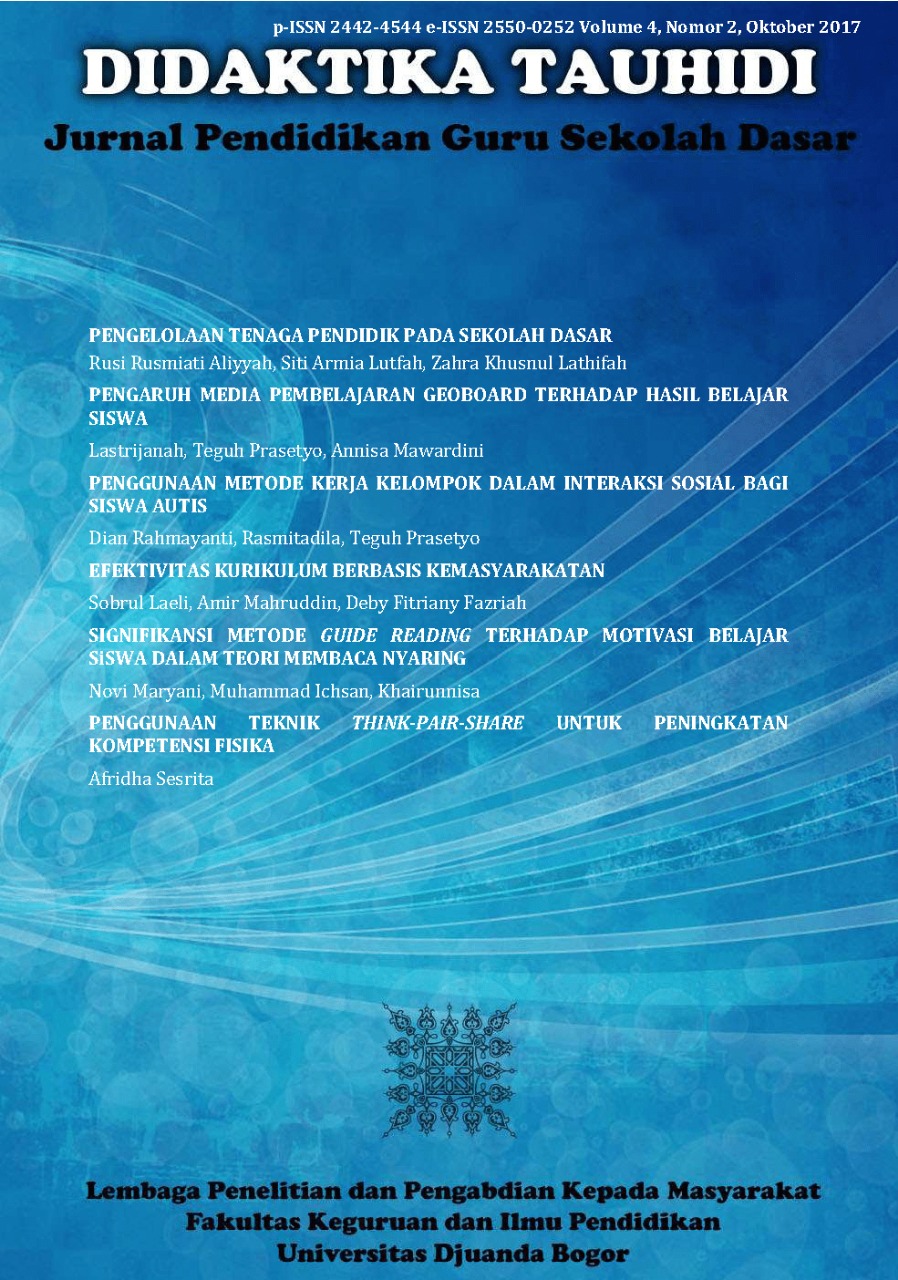SIGNIFIKANSI METODE GUIDE READING TERHADAP MOTIVASI BELAJAR SISWA DALAM TEORI MEMBACA NYARING
Main Article Content
Abstract
Penelitian ini memiliki tujuan untuk mengetahui apakah ada ataupun tidak ada signifikansi metode guide reading terhadap motivasi belajar siswa di kelas I SDN 4 Cisande Kabupaten Sukabumi. Penelitian ini menggunakan metode korelasi, dengan sampel sebanyak 31 siswa. Penggunaan instrumennya berupa tes berupa Lembar Kerja Proses (LKP) dan angket. Hasil penelitian dari variabel motivasi belajar siswa di SDN 4 Cisande dikatakan rendah, bisa terlihat dari hasil perolehan evaluasi siswa yang masih dibawah kriteria ketuntasan minimal (KKM). Berdasarkan hasil analisis data deskriptif metode guide reading diperoleh nilai tertinggi 288 dan nilai terendah 182, sedangkan hasil analisis data deskriptif motivasi belajar siswa memiliki nilai tertinggi 85 serta nilai terendah 70. Adapun nilai Fhitung=0.545<Ftabel=1.85 yang berarti data bersifat linear. Pada analisis data, persamaan regresi dalam penelitian ini diperoleh data Y=71.985+0.022. Serta koefisien determinasi diperoleh data 0.1232=0.015 atau 1.5% variabel X menentukan variabel Y. Uji signifikansi melalui uji t, diperoleh nilai thitung=0.665<ttabel=0.725 dengan dk 31, dan hasil signifikansi 0.511>0,05. Hasil uji hipotesis didapat Phitung<Ptabel sehingga Ha tolah dan Ho terima. Penelitian ini menyatakan bahwa tidak ada pengaruh yang signifikan antara metode guide reading terhadap motivasi belajar siswa di kelas I SDN 4 Cisande Kabupaten Sukabumi.
Kata Kunci: membaca nyaring, metode guide reading, motivasi belajar.
GUIDE READING METHOD ON STUDENTS’ LEARNING MOTIVATION IN READING LOUDLY LESSON
ABSTRACT
Guide reading Method is a guided learning method aimed to help students in using learning strategy to read independently. While learning motivation is a strong urge and power to achieve certain goals. This research is aimed to find out whether or not the guide reading method affects students’ learning motivation in One Grade of SDN 4 Cisande, Sukabumi. This research used correlation method, while the population in SDN 4 Cisande is 34 students and the total samples is 31 students. Instruments used in this research are process worksheet and questionnaire. The data analysis technique was helped by SPSS 16.0 application for Windows. The result shows that students’ learning motivation of SDN 4 Cisande is low. It can be seen in the score of the students which are still below the passing grade. Based on analysis of descriptive data of Students’ score, the highest score is 288 and the lowest is 182, while the result of descriptive data analysis of students’ learning motivation, the highest score is 85 and the lowest is 70. In normality test, it is obtained significance data 0.188>0,05 which means score distributes normally. In linearity test, it is obtained significance score 0.428>0,05, and score of Fcount=0.545<Ftable=1.85 which means the data is linear. In data analysis, regression equation in this research obtained data Y=71.985+0.022. And data for determination coefficient is 0.1232=0.015 or 1.5% x variable determines Y variable. Significance test through t test, it is obtained score tcount=0.665<ttable=0.725 with dk 31, and significance result 0.511>0,05. The result of hypothesis is Pcount<Ptable so Ha is rejected and Hois accepted. It means that Guide reading Method does not affect learning motivation of students in one grade SDN 4 Cisande, Sukabumi significantly.
Article Details
1. PROPOSED POLICY FOR JOURNALS THAT OFFER OPEN ACCESS
Authors who publish with this journal agree to the following terms:
- Authors retain copyright and grant the journal right of first publication with the work simultaneously licensed under a Creative Commons Attribution License that allows others to share the work with an acknowledgement of the work's authorship and initial publication in this journal.
- Authors are able to enter into separate, additional contractual arrangements for the non-exclusive distribution of the journal's published version of the work (e.g., post it to an institutional repository or publish it in a book), with an acknowledgement of its initial publication in this journal.
- Authors are permitted and encouraged to post their work online (e.g., in institutional repositories or on their website) prior to and during the submission process, as it can lead to productive exchanges, as well as earlier and greater citation of published work (See The Effect of Open Access).
2. PROPOSED POLICY FOR JOURNALS THAT OFFER DELAYED OPEN ACCESS
Authors who publish with this journal agree to the following terms:
- Authors retain copyright and grant the journal right of first publication, with the work [SPECIFY PERIOD OF TIME] after publication simultaneously licensed under a Creative Commons Attribution License that allows others to share the work with an acknowledgement of the work's authorship and initial publication in this journal.
- Authors are able to enter into separate, additional contractual arrangements for the non-exclusive distribution of the journal's published version of the work (e.g., post it to an institutional repository or publish it in a book), with an acknowledgement of its initial publication in this journal.
- Authors are permitted and encouraged to post their work online (e.g., in institutional repositories or on their website) prior to and during the submission process, as it can lead to productive exchanges, as well as earlier and greater citation of published work (See The Effect of Open Access).

References
Dalman. 2014. Keterangan membaca. Raja grafindo, Jakarta.
Emzir. 2011. Metodologi penelitian pendidikan kuantitatif dan kualitatif. Raja Grafindo, Jakarta.
Fathurrohman P. 2007. Strategi belajar mengajar melalui penanaman konsep umum dan konsep islami. Refika Aditama, Bandung.
Kartajaya H. 2010. Brand operation the official MIM academy course book. Esensi Erlangga Group, Jakarta.
Rahim F. 2009. Pengajaran membaca di sekolah dasar. Bumi Aksara, Jakarta.
Sardiman. 2011. Interaksi dan motivasi belajar mengajar. Raja Grafindo Persada, Jakarta.
Sumantri dkk. 2015. Strategi pembelajaran teori dan praktik di tingkat pendidikan dasar. Raja Grafindo Persada, Jakarta.
Tarigan HG. 2015. Membaca ekspresif. Angkasa, Bandung.
Yunus A. 2012. Pembelajaran membaca berbasis
pendidikan karakter. Refika Aditama, Bandung.

